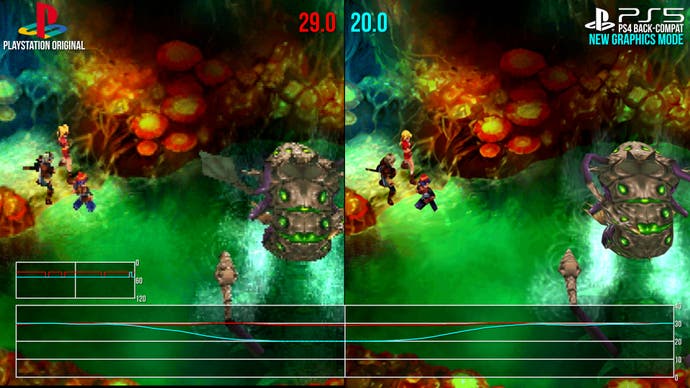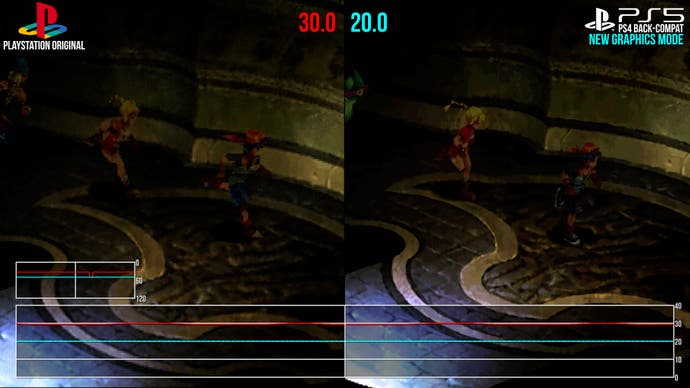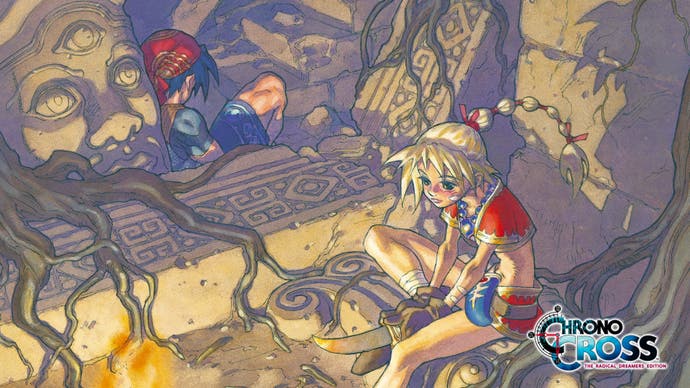The new Chrono Cross remaster runs worse on PS5 than the original on PS1
Radical Nightmares Edition.
23 years on from its original release, Chrono Cross: The Radical Dreamers Edition revives one of the true gems of the PS1 era with upgraded visuals and a handful of extras. It's out on last-gen PS4 and Xbox One machines, plus Switch and PC, with back-compat allowing the game to run on PS5 and Xbox Series X/S as well. Regardless of platform though, it's a pleasure to see one of Squaresoft's great JRPGs remastered, but it's certainly not a perfect package. Stark changes have been made to 2D pre-rendered backdrops, changing the look significantly, while the frame-rate is far less consistent than you'd expect from a remaster of a game made four generations ago.
So is the Radical Dreamers Edition the best way to play Chrono Cross, despite these issues, or is it still better to enjoy the original - perhaps augmented with a CRT or an HDMI scaler like a Retrotink 5X Pro?
Before answering that question, let's take a brief look at what changes have been made. The first thing you'll notice is that select character models have been upgraded, character art has been redrawn, and backgrounds have been processed with a form of AI upscale. All of these changes can be toggled with a single option in a front-end launcher, between a new and classic modes - but alas, none of them can be toggled individually. It's all or nothing.
Regardless of which mode you choose, there are universal tweaks to the Chrono Cross' remaster. Firstly, there's a change to the iconic opening FMV sequence; a higher-resolution version is now used, with noise removed and clearer text - a very welcome improvement on the PS1 original. However, the downside is the improvements end there, and later FMVs remain raw and untouched. Also unfortunate is that the music in all FMVs is heavily compressed, seemingly presented at a similar quality as the PS1 original. In game? The good news is Yasunori Mitsuda's beautiful, sample-based soundtrack shines. It remains a true highlight of the Chrono Cross experience, and while the arrangements are left as-is, newly orchestrated tracks are at least added to this remaster's front-end launcher.
What of the visuals, then? The biggest tweak is the AI processing of the 2D background assets to fit the boosted resolution. However, due to the dithering inherent on the original PS1 backdrops - seemingly used as a source for this project - this does result in some artefacting on areas with a pure colour element (sky blues for example). The result is at times pleasant, creating a watercolour effect that suits Chrono Cross' aesthetic. In other spots though, new details are added which weren't intended; artefacts like a repeat wave and banding are visible at times, while shop signs present with an unusual pattern. Overall the preference is to use the AI upscaled backdrops of the new mode, if mainly for consistency with the new 3D models - but it's not always an ideal solution.
There are more changes too. For both new and classic graphics modes, for all 3D elements (character models and 3D battle sequences) we measure a native resolution in the 900p to 936p region. The new character models are reserved just for the new graphics mode though, and this also sports a crisp 1080p HUD overlay. These revised 3D models are found on both PS4 and Switch at matching quality. Meanwhile, the classic mode uses the original PS1 models, and also reinstates its 240p backdrops and portraits, with chunkier on-screen text. This doesn't look great blown up to a 1080p or 4K display, especially in the overworld where we have crisply presented 3D elements running on top of pixellated map. Again the preference is to use the new mode on bigger displays.
One clear trouble spot in the remaster is performance. To put it bluntly, frame-rates on PS5 and on Switch are as low as the PS1 original - and at times worse while the 'new' graphics mode is selected. Issues are apparent from the off, with the very first opening hallway dropping to 20fps compared to 30fps on the PS1 original. This isn't as low as it can go either, as more taxing scenes can see the frame-rate cap shift to 20, 15 or even 10fps. This isn't to say that the original release was perfect - the original PlayStation ran the game with a wildly fluctuating frame-rate between 10 and 30fps too - but it is concerning that a remaster running on modern consoles actually ends up hitting lower frame-rates in some of the same scenes.


Selecting the classic mode in the remaster menu does improve things, but doesn't guarantee a lock at 30fps. In broad terms it appears to put frame-rates on par with the PS1's original again, with battles still seeing drops to 15fps and under. That said, regardless of mode used, additional hitches are introduced during battles in the remaster - such as during the post-battle victory pose - that were not present on the PS1 original.
All of the performance issues raise a question: how is such low performance possible so many years on from its 1999 release? One possibility is that the game is running as an emulated PS1 game, rather than being remade from the ground up for modern systems. Backing this theory is the presence of virtual PS1 memory cards in the save menu, while the PC install directory even shows two archive files for each physical disc. Proper remakes are undoubtedly more time-consuming than adding graphical tweaks and extra modes to an emulated version, but it's hard to imagine that Square Enix visualised this inconsistency as the final result.
Given the performance issues on PS5 and Switch, we wondered if the game might run better and be more enjoyable to play on PC. Sadly, it's much the same from what we were able to test - the opening corridor remains at 20fps in the new graphics mode, and battles drop to 15fps and under - even on a Titan RTX machine. It's clear that overall system horsepower isn't a limit here, but there must be an issue of some kind with the emulation that is contributing to these glaringly low frame-rates. The only difference on PC compared to console editions is that you can press Escape to access a graphics menu, which shows that the game is running with MSAA and FXAA and allows access to higher output resolutions - not really a solution to the remaster's issues.


So our final recommendations then: if you're lucky enough to own the original game and hardware, then that remains the best way to play. Using tools like a RetroTink 5X HDMI scaler can be a clever way to make the game look better on modern displays without changing its character, while the select few that still have CRT TVs or monitors in their possession can enjoy the original presentation.
If you don't have the original Chrono Cross to hand, then the remaster still has some value. If you pick up the Switch release, playing in handheld mode drops the resolution to 720p, bringing the 2D and 3D elements closer together in presentation. And regardless of platform, the story, gameplay and atmosphere of Squaresoft's classic JRPG still resonate in 2022 - despite some of the technical and artistic limitations.
Ultimately then, this remaster is something of a disappointment. Chrono Cross is an undoubted cult classic, but the Radical Dreamers Edition underperforms in terms of both visuals and performance. While some issues might be able to be fixed post-launch, the challenges here should prompt questions at Square Enix as to the validity of their approach to porting PlayStation classics.


